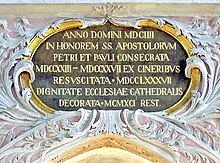
Back Anno Domini Afrikaans Christliche Zeitrechnung ALS ዓ.ም. Amharic AO ANN بعد الميلاد Arabic بعد لميلاد ARY بعد الميلاد ARZ Anno Domini AST Miladi tarix Azerbaijani Anno Domini BCL

The terms anno Domini (AD) and before Christ (BC) are used when designating years in the Gregorian and Julian calendars. The term anno Domini is Medieval Latin and means "in the year of the Lord"[1] but is often presented using "our Lord" instead of "the Lord",[2][3] taken from the full original phrase "anno Domini nostri Jesu Christi", which translates to "in the year of our Lord Jesus Christ". The form "BC" is specific to English, and equivalent abbreviations are used in other languages: the Latin form, rarely used in English, is ante Christum natum (ACN) or ante Christum (AC).
This calendar era takes as its epoch the traditionally reckoned year of the conception or birth of Jesus. Years AD are counted forward since that epoch and years BC are counted backward from the epoch. There is no year zero in this scheme; thus the year AD 1 immediately follows the year 1 BC. This dating system was devised in 525 by Dionysius Exiguus but was not widely used until the 9th century.[4][5] (Modern scholars believe that the actual date of birth of Jesus was about 5 BC.)
Terminology that is viewed by some as being more neutral and inclusive of non-Christian people is to call this the Common Era (abbreviated as CE), with the preceding years referred to as Before the Common Era (BCE). Astronomical year numbering and ISO 8601 avoid words or abbreviations related to Christianity, but use the same numbers for AD years (but not for BC years in the case of astronomical years; e.g., 1 BC is year 0, 45 BC is year −44).
- ^ "anno Domini". Merriam Webster Online Dictionary. Retrieved 9 May 2024.
Etymology: Medieval Latin, in the year of the Lord
- ^ "Anno Domini". Online Etymology Dictionary. Retrieved 4 October 2011.
- ^ Blackburn & Holford-Strevens 2003, p. 782 "since AD stands for anno Domini, 'in the year of (Our) Lord'"
- ^ Teresi, Dick (July 1997). "Zero". The Atlantic. Archived from the original on 5 June 2022.
- ^ Blackburn & Holford-Strevens 2003, pp. 778–79.